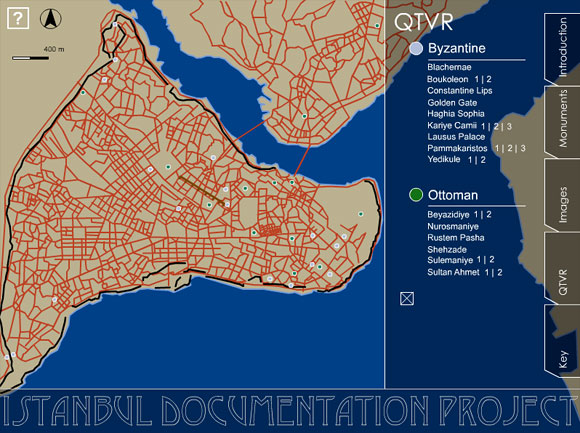|
| |
|
 |
360° PANORAMAS |
 |
INTERACTIVE PLAN(S) |
 |
FEATURED PROJECT(S) |
 |
 |
 |
 |
 |
 |
 |
 |
|
|
 |
Select
one one of the links above for more information. |
 |
|
|
 |
Is there such a thing as "Islamic" architecture?
Style, culture, religion—what do we signify when we use
this adjective? On the one hand, it is common to find
the paired terms the "Abode of Islam" ( Dar al-Islam )
and the "Abode of War" ( Dar al-Harb ) in Arabic,
Persian, and Turkish primary sources. Authors from a particular
social stratum identified an Islamic world in distinction
to an uncivilized, chaotic territory beyond the folds
of civilization. The Caliphate and its successor states,
stretching from Spain to North India, did rely on an ideology
of unity. Could there not be aesthetic, design and architectural
ideals coinciding with this ideal realm that shaped the
development of architectural practice? If so, is contemporary
Islamic architecture now lost like the age of these empires?
As Hasan-Uddin Khan, Martin Frishman and others have
pointed out, the use of "Islamic" to
describe architecture, urbanism, and art is problematic. The development of
this designation finds its foundations on a history
of European scholarship more than an all-pervasive stylistic
or cultural reality. Unlike the Roman Empire, the early
Caliphate had no model of architecture or town planning
to export from its Arabian heartland. And where built
elements did exist, it is difficult to discern the dividing
line between Arab and Islamic culture. If we do focus
on the common institutions and ideologies that would
make it possible for scholars, artists, merchants and
pilgrims to travel across distinct regions, often the Dar
al-Islam amounted to an imagined abode of the elite. Even later in history,
when a Dar al-Islam did coalesce, few Muslim jurists commented on
a common prescription for the layout of all mosques. Their focus instead honed
in on prescriptive codes of conduct as outlined in and interpreted from the
Qur'an, Hadith and
previous juridical decisions. If we are looking for an Islamic Architecture,
we should focus on architectural elements that facilitate codes of conduct
within the multiple regional and historical contexts of
the Islamic world.
|
Use of the term Islamic architecture then
signals us to pay close attention to the means by which
diverse peoples across the world integrate cultural-historical
contexts, regional styles, functional needs, and environmental
possibilities with their religious practices. It also
points us to the use of Islam and architecture to represent
and legitimize modes of status, state, and empire throughout
history.  |
|
|
|
 |
|

Affluent house in the archaeological
site. The
courtyard (Qajar period)
Archaeological site: View from the barracks at the base
of the Citadel (Timurid, Safavid, and Zand
periods)
Citadel and general city view, the archaeological
site; View
facing north, taken midway between the Citadel and
the main entry gate (Timurid, Safavid,
and Zand periods)
The archaeological site; View
from the barracks at the base of the citadel (Timurid, Safavid,
and Zand periods)
The Citadel and remains of the archaeological site; View facing northeast,
taken from the main entry gate (Timurid, Safavid, and Zand periods)
View of the Citadel and the archaeological remains, the archaeological site;
View facing northeast, taken from the main entry gate (Timurid,
Safavid, and Zand periods)
|

Building: The Alhambra
Date: 1338 –1390
Interior view of entrance to Nasrid Palaces
Interior view #1 of Mexuar
Interior view #2 of Mexuar
Interior view of the Oratory
Exterior view of the Façade of Comares and Court of the Golden Room
Interior view of Golden Room
Exterior view of the Court of Myrtles
Interior view of the Barca Gallery (Hall of the Boat)
Interior view between the Barca Gallery and the Hall of Ambassadors
Interior view #1 of the Hall of Ambassadors
Interior view #2 of the Hall of Ambassadors
Exterior view #1 of the Patio of Wrought Iron Grille
Exterior view #2 of the Patio of Wrought Iron Grille
Exterior view #1 of the Court of the Lions
Exterior view #2 of the Court of the Lions
Exterior view #1 between the Court of the Lions and the Hall of the Mocarabes
Exterior view #2 between the Court of the Lions and the Hall of the Mocarabes
Exterior view #3 between the Court of the Lions and the Hall of the Mocarabes
|

Exterior view between the Court of the Lions and the Hall of the Abencerrajes
Interior view of the Hall of the Abencerrajes
Exterior view #1 between the Court of the Lions and the Hall of the Kings
Exterior view #1 between the Court of the Lions and the Hall of the Kings
Exterior view #3 between the Court of the Lions and the Hall of the Kings
Interior view of the Hall of the Kings
Exterior view between the Court of the Lions and the Hall of the Two Sisters
Interior view of the Hall of the Two Sisters
Interior view of passage to the Hall of the Two Sisters
Interior view of the Mirador de Daraxa
Interior view of the Partal Palace
Exterior view #1 of the Partal Palace
Exterior view #2 of the Partal Palace
Exterior view #3 of the Partal Palace
Exterior view #4 of the Partal Palace
Exterior view #1 of the gardens of the Partal Palace
Exterior view #2 of the gardens of the Partal Palace
|

General view of the Istanbul from the roof of the
German Archaeological Institute building, 2003
Building:
Beyazidiye Mosque Complex
Date:
1501–1506
View of courtyard
Interior view
Building:
Nurosmaniye Camii
Date:
1748
Interior view
Exterior view of courtyard
Interior view
Interior
view
|
Exterior view of courtyard
Interior view
Building: The Great Mosque of Mopti
Date: 1936-1943
Exterior node at the northeast corner of the mosque
Exterior node at the qibla wall
Exterior node at the main entrance
Exterior node taken on the roof, facing west
Interior node facing north with mihrab to the right
|
Building: Shah Na'met Allah Vali
Complex
Architect: Unknown
Date: 1436; Additions throughout Safavid period
View of interior courtyard of Complex View of Balcony 124a
View of first floor bath
View of Room 212
View of second floor hallway
View of third floor room
View of the Palm Court
|

View of Room 105
View of Room 132
Balcony on the south facade
Building: Friday Mosque of Yazd
Architect: Unknown
Date: 1375 and later (Muzaffarid period)
Exterior view of minarets and iwan
Exterior view of courtyard and entrance
Exterior view of inner courtyard
Interior view of mihrab
View of Interior courtyard |
|
|
 |
|
 |
|
| Experience the
Istanbul, Süleymaniye Complex Interactive Plan. Go there. |
|
|
|
|
 |
 |
 |
 |
 |
|
| Experience the Istanbul
Documentation Project Web site. Go
there. |
|
|
 |
|
 |

 |
 |


